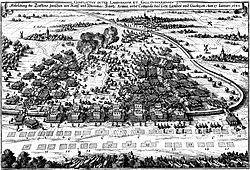Battle of Kempen facts for kids
Quick facts for kids Battle of Kempen |
|||||||
|---|---|---|---|---|---|---|---|
| Part of the Thirty Years' War | |||||||
 Battle of Kempen; engraving by Matthäus Merian |
|||||||
|
|||||||
| Belligerents | |||||||
| Commanders and leaders | |||||||
| Strength | |||||||
| 9,500 23 guns |
9,000 6 guns |
||||||
| Casualties and losses | |||||||
| 660 killed or wounded | c. 7,000 killed, wounded or captured | ||||||
The Battle of Kempen, also known as Battle of the Kempen Heights, or Battle of Hückelsmay, took place on 17 January 1642 during the Thirty Years' War, outside Kempen, now part of North Rhine-Westphalia. A combined Franco-Hessian army, led by de Guébriant and von Eberstein respectively, defeated an Imperial force under General de Lamboy.
The Imperial army of around 9,000 men disintegrated, with the majority either captured or killed. Defeat at Kempen ended Imperial plans for an invasion of Champagne, and temporarily secured French-Hessian control of the Lower Rhine.
Contents
Background
In late 1641, de Lamboy and his Imperial army of 9,000 men established winter quarters in Kempen, then part of the Electorate of Cologne, an ally of Emperor Ferdinand. He was instructed to await the arrival of additional Imperial troops under Melchior Graf von Hatzfeldt. Once combined, they would invade the French province of Champagne, while the Spanish Army of Flanders simultaneously entered Picardy.
Learning of this, Cardinal Richelieu, then Chief minister of France, recalled Guébriant from Northern Germany, and given him command of the French Army of Germany. Numbering around 2,000 infantry and 3,500 cavalry, this was made up largely of German mercenaries known as Weimarians. Like Guébriant himself, they had previously served Bernard of Saxe-Weimar until his death in 1639, after which they were recruited by France.
In December 1641, Guébriant was reinforced by Eberstein's Hessian army of 4,000 men, split equally between infantry and cavalry. By this stage of the war, the limiting factor in any campaign was securing supplies and forage for men and horses. In order to deny these to Lamboy, on 11 January 1642 the Franco-Hessian army crossed the Rhine at Wesel, and began to ravage lands around his base. On 15 January, the French cavalry beat off a reconnaissance party led by Heinrich von Mercy, Lamboy's deputy and brother of the Bavarian general Franz von Mercy.
Prisoners informed Guébriant that Hatzfeldt had reached Cologne with 7,000 men, and he decided to attack Lamboy before the two armies could combine. Although more than a third of Lamboy's men were unavailable due to sickness or lack of weapons, he ignored instructions to avoid combat until joined by Hatzfeldt. Instead, he established his troops in a triangle on the heights south of Kempen, along a line running from Hüls to St Tönis. With a ditch covering his positions in front and the infantry placed behind hedges and in buildings, Lamboy was confident he could beat off any assault.
The Franco-Hessian army were short of supplies, which combined with Hatzfeldt's presence meant Guébriant had to act quickly, or not at all. On 16 January, his own troops were ordered to concentrate around Linn in preparation for an attack, while Eberstein's men moved up from Wesel to the nearby village of Uerdingen. To speed up progress, the heavy guns were left behind.
Battle
The battle began with a short artillery bombardment, while Guébriant formed his infantry into three columns. These would attack simultaneously all along the Imperial lines, opening a breach for Eberstein's cavalry to storm into their rear. The initial assault met fierce resistance before the French captured part of the Imperial line, moved up their guns, and began firing at close range. At the same time, the Hessian cavalry routed their opponents, who fled; deprived of their support, and unable to respond to the French artillery, the Imperial infantry surrendered.
Although some 2,000 cavalry escaped and joined up with Hatzfeldt, the Imperial army was largely destroyed. Another 2,000 died on the battlefield, while Lamboy and Mercy were among the 4,000 to 5,000 captured, along with the artillery and baggage. French casualties consisted of 160 dead, plus another 500 wounded.
Aftermath
The destruction of Lamboy's army ended plans for a joint Spanish-Imperial invasion of Northern France, and Hatzfeld withdrew his troops to the fortress city of Jülich. Victory allowed Guébriant to base himself in the Electorate of Cologne, from where he could threaten both the Spanish Army of Flanders and Imperial/Bavarian forces in southern Germany.
Over the next months, the French captured important towns in the region, including Kempen, Neuss and Düren. To contain the Franco-Hessian advance, Bavarian troops under Joachim Christian von der Wahl joined Hatzfeldt in May. Together, they lifted the siege of Lechenich and took camp at Zons while the French and Hessians entrenched themselves at Uerdingen. Shortage of supplies forced the opposing armies largely to inactivity throughout the summer except for cavalry raids by the Bavarian general Johann von Werth. Despite his achievements, Guébriant was forced to remain in the Rhineland and distract the Imperial-Bavarian forces, preventing his army from undertaking further offensive operations.
Most of the prisoners were quickly exchanged, although Mercy remained in French custody until September 1643, while Lamboy was not released until six months later. Guébriant was promoted Marshal of France after the battle; in 1643, he led his troops south into Baden-Württemberg, and was killed at the siege of Rottweil in November.
Sources


